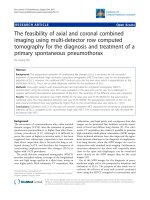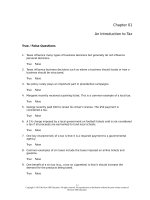Immunogenicity of measles vaccine of measles and rubella combined vaccine manufactering by polyvac
Bạn đang xem bản rút gọn của tài liệu. Xem và tải ngay bản đầy đủ của tài liệu tại đây (86.17 KB, 5 trang )
Journal of military pharmaco-medicine no8-2019
IMMUNOGENICITY OF MEASLES VACCINE OF MEASLES
AND RUBELLA COMBINED VACCINE
MANUFACTERING BY POLYVAC
Nguyen Xuan Dong1; Dinh Hong Duong2; Nguyen Thuy Huong3
Ha The Tan2; Vu Tung Son2; Vu Ngoc Hoan2
SUMMARY
Objectives: To assess immunogenicity of measles vaccine of measles and rubella combined
vaccine. Subjects and methods: Randomized, controlled and single-blind clinical trial study was
conducted on 756 people aged from 1 to 45 years old in Hanam and Hoabinh provinces,
measured measles antibody titer by EIA technique, analyzed indexes to evaluate
immunogenicity. Results: In negative antibody group, post-vaccination seroconversion rate was
100%. In positive antibody group, measles and rubella combined vaccine, post-vaccination
geometric mean titer was 46.85 EIA units, significantly higher than pre-vaccination and control
vaccine, with a remarkable growth post-vaccination antibody titer.
* Keywords: Measles and rubella combined vaccine; Immunogenicity.
INTRODUCTION
In Vietnam, after implementing vaccines
in the expanded immunization program,
the epidemic situation of measles has
changed positively with the trend of
substantially decline morbidity and mortality.
However, measles is still circulating with a
3 - 5 year period of epidemic, the number
of cases has still been high [1]. The goal
of eliminating measles nationwide has
been continuously pushed back over time
and faced many difficulties and challenges,
partly due to the lack of vaccine sources.
The vaccine against rubella and rubella
used previously was imported from India.
In fulfillment of a cost decrease in the
expanded immunization program and
actively control, prevent these measles,
POLYVAC has successfully produced
measles and rubella combined vaccine
(MRVAC) according to technology transfer
from Japan. Before applying in community,
we conducted this study: To assess the
immunogenicity of measles vaccine of
MRVAC vaccine.
1. Military Institute of Medicine Preventive
2. Vietnam Military Medical Univerity
3. Center for Research and Production of Vaccines and Biologicals
Corresponding author: Nguyen Xuan Dong ()
Date received: 05/09/2019
Date accepted: 10/10/2019
126
Journal of military pharmaco-medicine no8-2019
SUBJECTS AND METHODS
+ Lot number: MR-0115; production
date: November 4, 2015; expiry date:
November 4, 2017.
1. Subjects.
* Volunteers:
A total of 756 people in Hanam and
Hoabinh provinces participated in the study,
included 420 children from 1 to 2 years
old, 168 people over 2 to under 18 years
old and 168 people from 18 to 45 years
old. There were 504 subjects vaccinated
MRVAC and 252 subjects immunized
control vaccine. Research time: from April
8, 2016 to July 27, 2016.
* Vaccines:
- Study vaccine: MRVAC vaccine
produced by POLYVAC.
+ Ingredients: Each bottle included 10
doses of measles vaccine is reconstituted
with 5.5 mL solvent. Each dose 0.5 mL
included:
Live, further attenuated AIK-C measles
strain ≥ 1.000 PFU.
Live, further attenuated Takahashi rubella
strain ≥ 1.000 PFU.
Stabilizers: Lactose 2%; D-sorbitol 0.72%;
L-sodium glutamate 0.4%; hydrolized
gelatin 0.36%.
Antibiotics: Erythromycin ≤ 12.5 µg;
kanamycin ≤ 12.5 µg.
Control vaccine: MR vaccine produced
by India. Lot number: 012N4072; Production
date: July 2014; expiry date: August 1,
2016.
2. Methods.
* Research design:
Randomized, controlled and singleblind clinical trial study was conducted.
M0 blood sample was taken immediately
before vaccination, M1 sample was
collected 42 - 56 days after immunization
to quantify pre- and post-vaccination measles
antibody (figure 1). No sooner were M0
and M1 blood samples gathered at the
commune health stations than they were
transferred to Preventive Medicine Center
of Hanam province and Kimboi district to
conduct on serum centrifugation. Then
serum samples were quantified antibody
titer by enzyme immuno assay (EIA)
technique at Vaccine Immunization Board,
Department of Immunology and Molecular
Biology, National Institute of Hygiene and
Epidemiology, converting international
units with the formula: EIA unit x 45 =
milli-international units/mL (mIU/mL).
Vaccination
0
42
Collecting M0 blood sample
56
day
Collecting M1 blood sample
Figure 1: Vaccination and taking blood sample diagram.
127
Journal of military pharmaco-medicine no8-2019
A total of 756 subjects had their blood
drawn for the first time, but when
collecting M1 blood samples, 23 subjects
withdrew from the study, including: 2
cases of identical serum code, someone
refused second blood sample collection
and other left the residence, so they could
not participate (although these subjects
had pledged that they did not leave the
locality within 2 months before entering
the study), only 733 blood samples were
quantified post-vaccination antibody titer.
Immunogenicity of measles vaccine
has been assessed by some major
indexes: seroconversion rate, an antibody
titre increase, pre- and post-vaccination
geometric mean titre (GMT) follow in
study and age groups.
* Ethical issues in research:
This study complies with ethical principles
of Declaration of Helsinki and the revisions,
current regulations of Ministry of Health
on Good Clinical Practice (GCP).
RESULTS AND DISCUSSION
1. In negative antibody group.
Table 1: Seroconversion rate of measles antibody.
Age group
MRVAC
Control vaccine
n
Number
%
n
Number
%
1 - 2 years
13
13
100
5
5
100
> 2 to < 18 years
11
11
100
4
4
100
18 - 45 years
6
6
100
2
2
100
30
30
100
11
11
100
Total
Overall as well as separate analysis by age group, seroconversion rate of measles
antibodies in both study groups was 100%. Most of the participants in our study were
vaccinated with at least one measles vaccine or were infected, so the number of
subjects without antibodies was low. After MRVAC vaccination, seroconversion rate
was similar to study by Doan Huy Hau et al (100%), who clinical tried a single vaccine
MVVAC containing AIK-C measles strain like MRVAC and Takeuchi Y (94.5%) who
tried HF vaccines with the same formula on Japanese children [2, 4].
Table 2: Post-vaccination GMT of measles antibody follow in study groups.
Log2GMT (95%CI)
GMT (95%CI)
MRVAC (n = 30)
Control vaccine (n = 11)
5.35
4.71
(5.05 - 5.65)
(4.20 - 5.23)
40.79
26.17
(33.13 - 50.21)
(18.38 - 37.53)
p
0.029
The post-vaccination GMT of two study groups were respectively 40.79 EIA units
(1,835.6 mIU/mL) and 26.17 EIA units (1,177.7 mIU/mL). Log2GMT of MRVAC group
128
Journal of military pharmaco-medicine no8-2019
was significantly higher than the control group (p < 0.05, independent sample t-test).
Thus, in negative antibody group, immune response after MRVAC vaccination had
been stronger than control vaccine and been equivalent to the study by Doan Huy Hau
(5.31 Log2 EIA unit) [2].
2. In positive antibody group.
With positive antibody group, the growth of antibody titer was not as strong as the
negative group. Measuring immune response after vaccination by indexes including the
growth of GMT, multi-fold increase of antibody titer from pre- to post-vaccination [5].
Table 3: Pre- and post-vaccination GMT of measles antibody in two study groups.
MRVAC
Control vaccine
Pre-vac (1)
Post-vac (2)
Pre-vac (3)
Post-vac (4)
(n = 458)
(n = 458)
(n = 234)
(n = 234)
p
Log2GMT
4.52
5.55
4.58
5.14
(1;2): 0.001
(95%CI)
(4.42 - 4.61)
(5.49 - 5.60)
(4.44 - 4.73)
(5.03 - 5.24)
(3;4): 0.001
22.94
46.85
23.92
35.26
(1;3): 0.382
(21.41 - 24.42)
(44.94 - 48.50)
(21.71 - 26.54)
(32.67 - 37.79)
(2;4): 0.001
GMT
(95%CI)
Pre- and post-vaccination GMT was
respectively
22.94
EIA
units
(1,032.3 mIU/mL) and 46.85 EIA units
(2,108.3 mIU/mL) in the MRVAC group;
23.75 EIA units (1,068.8 mIU/mL) and
35.26 EIA units (1,586.7 mIU/mL) in the
control group. Data analysis showed
that post-vaccination Log2 GMT was
significantly higher than pre-vaccination in
both study groups (p < 0.05, Wilcoxon
test). Thus, both vaccines even increased
measles antibody titer in possitive
antibody group. There was no significant
difference between pre-vaccination
Log2GMT in two study groups (p > 0.05,
Mann-Whitney test). However, postvaccination Log2GMT in MRVAC group
was higher than control group (p < 0.05,
Mann-Whitney test), which indicated
that MRVAC vaccine increased measles
antibody titer more remarkably than control
vaccine.
Table 4: The growth of post-vaccination measles antibody titer by study and age group.
Age group
Post-vac/pre-vac
antibody titer
MRVAC
n
Number
%
133
52.4
75
29.5
> 4 fold
46
< 2 fold
< 2 fold
1 - 2 years
> 2 to < 18
years
Control vaccine
2 - < 4 fold
2 - < 4 fold
> 4 fold
254
100
n
p
Number
%
90
68.7
26
19.8
18.1
15
11.5
32
32.0
33
67.3
36
36.0
14
28.6
32
32.0
2
4.1
131
49
0.004
0.001
129
Journal of military pharmaco-medicine no8-2019
< 2 fold
18
years
Total
45
79
76.0
11
10.5
> 4 fold
14
< 2 fold
2 - < 4 fold
2 - < 4 fold
46
85.2
8
14.8
13.5
0
0
244
53.3
169
72.2
122
26.6
48
20.5
92
20.1
17
7.3
104
458
> 4 fold
The growth of measles antibody titer
had been also an important criterion for
evaluating immune response of vaccines.
Data analysis in both study groups
showed that a less than 2 fold-increase in
antibody titer from pre- to post-vaccination
accounting for the highest proportion of
53.3 and 72.2%, respectively, from 2 to
under 4-fold occupying 26.6 and 20.5%,
from 4 and above-fold took up the lowest
with 20.1 and 7.3%. Comparison between
the two study groups, the rate of a less
than 2 fold-increase in the MRVAC group
was lower, but from 2 to under 4-fold and
from 4 and above-fold increase were
higher than control group by overall and
age group analysis. The difference was
statistically significant (p < 0.05, Chisquare test). The MRVAC vaccine rosed
antibody levels more strongly than control
vaccine. Measles antibody titer in our
study increased more remarkably than
study by Dang Thi Thanh Huyen et al,
who also conducted research on children
in Kimboi district, Hoabinh with the rate of
less than 2 fold, from 2 to under 4-fold
and from 4 and above-fold increase were
57.1%, 34.3% and 8.6%, respectively [3].
CONCLUSION
MRVAC vaccine achieved immunogenicity
requirements to measles virus through
130
54
234
0.017
0.001
evaluation parameters such as seroconversion
rate, high post-vaccination GMT, with a
marked increase in antibody titer, postcompared to pre-vaccination GMT and
immune response were stronger than the
control vaccine.
REFERENCES
1. Dang Thi Thanh Huyen, Duong Thi Hong.
Several epidemiological and clinical
characteristics of measles in Vietnam,
2013 - 2014. Vietnam Journal of Preventive
Medicine. 2016, XXVI, 4 (177), pp.98-106.
2. Doan Huy Hau, Dao Xuan Vinh, Dinh
Hong Duong et al. Evaluation of safety and
immunogenicity of the measles vaccine MVVAC
manufacturing by POLYVAC (phase 1 and 3).
Vietnam Journal of Preventive Medicine.
2011, XXI, 4, pp.110-117.
3. Dang Thi Thanh Huyen, Pham Ngoc Dinh,
Nguyen Van Cuong et al. Immunogenicity of
second dose measles vaccine at 18 months of
age in Kimboi district, Hoabinh province.
Vietnam Journal of Preventive Medicine.
2013, XXIII, 7 (143), pp.26-32.
4. Takeuchi Y, Togashi T, Sunakawa K et
al. Field trial of combined measles and rubella
live attenuated vaccine. Infectious Disease
Magazine. 2002, 76 (1), pp.56-62.
5. WHO. Guidelines on Clinical Evaluation
of Vaccines: Eegulatory Expectations. 2016.









